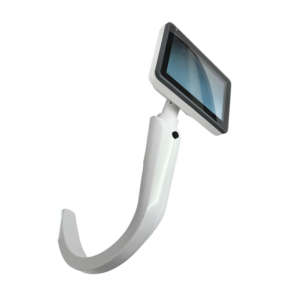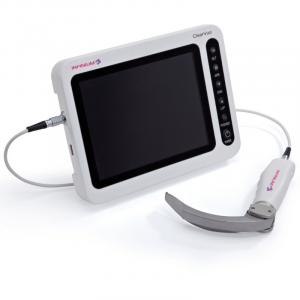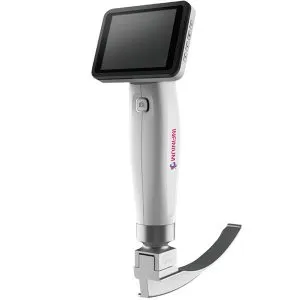Attempting difficult intubations with a traditional laryngoscope can sometimes increase the risk of failure or patient injury during the procedure. For a variety of reasons, the practitioner or responder will not be able to view the vocal cords, esophagus, and key parts of the anatomy in order to proceed safely. In some cases, broken teeth, dislodged dental work, damage to gums, and vocal cord spasms have been reported. This also can result in a delay or failure of successful intubation on the first and subsequent attempts.
If you suspect the intubation will be difficult ahead of time a video laryngoscope can increase the chances of success. In addition to a general and technical airway exam, having background information about the patient can speed the decision-making process tremendously.
Key Indicators of a Challenging Intubation and Difficult Airway
Genetic Syndromes
- Pierre Robin Syndrome: Micrograpthia (small jaw with receding chin), Macroglossia (tongue is larger in proportion to other parts of the mouth), Cleft soft palate
- Treachers Collins Syndrome: Auricular & ocular defect, molar & mandibular hypoplasia.
- Goldenhar’s Syndrome: Auricular and ocular defects, molar and mandibular hypoplasia; occipitalization of atlas.
- Down’s Syndrome: Poorly developed bridge of the nose or macroglossia ( abnormal enlargement of the tongue ).
- Kilppel-Feil Syndrome: Congenital fusion of cervical vertebrae and restriction of neck movement.
Infections
- Ludwig’s Angina or Abscess: Distortion of the airway and restriction of the range of motion of the jaws is an indicator of difficult intubation.
- Croup: Swelling of the epiglottis and vocal cords
- Supraglottitis: Swelling of the epiglottis and vocal cords
Arthritis of the Larynx
- Rheumatoid Arthritis: TMJ ankylosis, cricoarytenoid, restricted mobility of the cervical spine.
- Ankylosing spondylitis: Lack of mobility of the spine.
Tumors
- Benign Tumor: Distortion of the airway.
- Malignant Tumor: Fixation of the larynx to adjacent tissue.
Medical Procedures
- Surgery & Therapy Side Effects: Previous radiotherapy, serious oral, dental, laryngeal, tracheal, or TMJ surgical procedures.
- Previously Reported Complications: Current or previously reported dental damage, emergency tracheostomy in the past, etc.
Other Physical Conditions
- Acromegaly: Macroglossia, Prognanthism
- Visible Trauma: Oedema of airway, instability, haematoma.
- Obesity and Chronic Snoring: Short thick neck, or sleep apnea.
- Pregnancy
- Injury Requiring Spine Immobilization
- Acute Burns: Oedema of the airway.
- Preterm and Neonatal Intubations
- Elderly or Frail Physical Condition
Key Intubation Evaluations
Time is often short, but efficient general exams and technical airway evaluations will allow medical staff to assess difficult intubation cases and identify the indicators above before starting the process. Below we cover the basic steps in each:
General Exam
- Assess the patient’s general age and overall wellness. Elderly patients are more at risk.
- Determine if the patient displays non-standard anatomical traits such as small mouth, receding chin, high arched palate, large tongue, or morbid obesity.
- Check if there are mechanical limitations such as reduced mouth opening, post-radiotherapy, fibrosis, poor cervical spine movement or even physical features such as a large beard.
- Do a dental check for missing, prominent, or loose teeth and orthodontic equipment.
- Determine if the nasal cavity is freely open for airflow.
Technical Airway Evaluation
If time allows, any of these technical evaluations could help predict signs of a challenging intubation procedure.
- Assessment of vocal cords and glottic opening
- Mobility of the joints: TMJ or neck mobility issues
- The SAVVA test is the single best predictor of difficult laryngoscope intubation. It is defined by the sternomental distance from the upper border of the manubrium to the tip of the mentum with the neck fully extended and mouth closed. The smallest accepted value is 12.5cm.
- Determine the tongue size relative to the pharynx. Smaller is better.
- Mandibular space less than 6.5cm is an indication of difficulty.
- Challenges start to arise when the ratio of height to thyromental distance (RHTMD) is greater than 23.5cm.
- If the distance between mentum and hyoid bone is less than 6cm it won’t allow for optimal spacing.
Video Laryngoscope Equipment for Difficult Intubations
If it is determined that the intubation will potentially be difficult, a video laryngoscope system increases the chances of success with fewer problems during the procedure. This is particularly the case if the practitioner has less experience in the field. Read our article on The Benefits of Video Laryngoscopes to see why these devices have become a standard of care.
The ClearVue series from Infinium provides a high-quality cost-effective option for both emergency response and planned surgery with its full line of high-definition systems.




